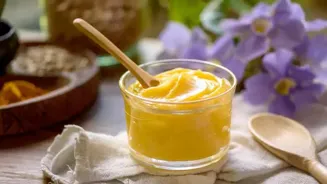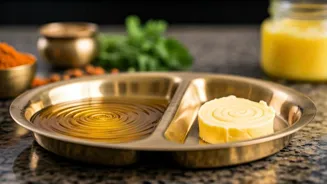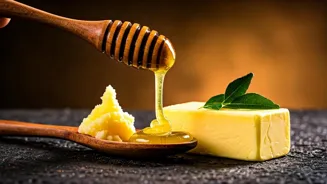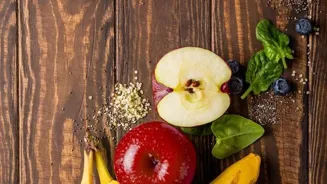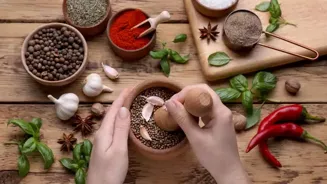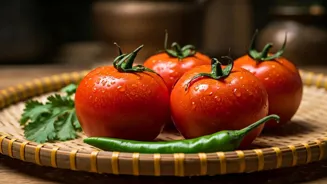Ghee, a type of clarified butter, holds a sacred place in Indian kitchens and culinary traditions. Known for its rich, nutty flavor and deep cultural significance,
ghee is more than just a cooking fat—it’s a symbol of purity and health. While store-bought ghee is readily available, nothing compares to the richness and authenticity of homemade ghee. The process of making ghee at home not only ensures superior taste and quality but also preserves its nutritional benefits. This article delves into the art of making perfect ghee, why homemade ghee is always better, and the science behind its health benefits.
The Traditional Process: A Slow and Sacred Ritual
Making ghee at home is a time-honored process that requires patience, care, and the right ingredients. Traditionally, ghee is made by first churning curd (yogurt) to obtain fresh butter. This butter is then heated slowly to remove the milk solids and water content, leaving behind pure, golden ghee. The slow cooking process gives ghee its distinct aroma and flavor, which is difficult to replicate with store-bought alternatives.
The purity and quality of homemade ghee depend largely on the milk used. Grass-fed cow’s milk is preferred, as it produces the richest and most flavorful butter. When the butter is clarified through the slow heating process, the milk solids (casein and lactose) separate from the fat. These solids are removed, leaving behind pure butterfat, which is what gives ghee its smooth texture and deep, toasted flavor.
Superior Flavor and Aroma
One of the most compelling reasons to make ghee at home is its unmatched flavor and aroma. Homemade ghee has a rich, nutty, and slightly caramelized taste, thanks to the slow cooking process. The milk solids, when heated, brown and add a delicious, roasted flavor to the fat. This process creates ghee that is far superior in taste compared to the uniform, often bland flavor of commercial ghee.
The aroma of fresh homemade ghee is also an essential part of its appeal. It is warm, comforting, and inviting, filling the kitchen with a scent that enhances the experience of cooking and eating. Store-bought ghee, often mass-produced and processed with preservatives, may lack the depth of fragrance and richness that comes from making it from scratch.

Nutritional Benefits: Pure and Natural
Homemade ghee is packed with nutrients that are beneficial to health. It is rich in short-chain fatty acids, which are easy to digest and provide a quick source of energy. These fatty acids help maintain a healthy gut by promoting the growth of beneficial bacteria. Additionally, ghee contains butyrate, a short-chain fatty acid that has been shown to support brain health, reduce inflammation, and improve metabolism.
Unlike commercial ghee, which may contain additives or impurities, homemade ghee is free from preservatives and chemicals. This makes it a healthier option, as it retains all the natural nutrients found in butter. Homemade ghee is also lactose-free, as the milk solids are removed during the clarification process, making it suitable for people who are lactose intolerant.
The presence of fat-soluble vitamins, such as vitamin A, D, E, and K, is another reason why homemade ghee is considered a health food. These vitamins are essential for maintaining healthy skin, bones, and immune function. The rich, natural fat content of ghee also aids in the absorption of these vitamins from other foods, making ghee a valuable addition to any diet.
The Importance of Purity: Homemade Ghee vs. Store-Bought Ghee
One of the main differences between homemade and store-bought ghee is the level of purity. Commercial ghee often undergoes heavy processing and may contain artificial flavor enhancers, colorants, or preservatives to prolong shelf life and standardize the product. On the other hand, homemade ghee is free from these additives and is made with fresh, natural ingredients, ensuring its purity.
Homemade ghee also allows for customization in terms of flavor and consistency. You can control the level of cooking, ensuring that the ghee is clarified to your exact preference—whether you prefer a lighter, golden hue or a richer, darker ghee with a more intense flavor. The homemade approach also allows for greater flexibility in terms of sourcing the best quality butter, which directly impacts the final product.
Healthier Cooking with Homemade Ghee
When used in cooking, homemade ghee offers several advantages over other cooking oils. It has a high smoke point, making it ideal for high-heat cooking methods such as frying and sautéing. Ghee’s stability at high temperatures means that it doesn’t break down and release harmful free radicals, unlike some vegetable oils or butter. This makes ghee a healthier option for cooking, especially for those concerned about the effects of overheating oils.
Additionally, ghee has been used in Ayurvedic medicine for centuries due to its healing properties. It is believed to promote digestive health, improve skin conditions, and balance the body’s internal systems. Ghee is considered a powerful anti-inflammatory agent and is often used to treat joint pain and inflammation, making it a useful addition to a wellness-focused diet.
The Joy of Homemade Ghee: A Connection to Tradition
Making ghee at home is more than just about flavor—it’s an experience that connects you to centuries of culinary tradition. It’s a reminder of the time and effort that goes into creating food from scratch, and the satisfaction that comes with making something so rich and nourishing with your own hands. The ritual of churning, heating, and clarifying butter allows for a deeper appreciation of the food you eat and the cultural significance behind it.
In a world that often values convenience over tradition, homemade ghee represents a return to authentic, mindful cooking. It’s not just about nourishing the body, but also about cultivating a deeper connection to the food we consume and the process of making it.
Conclusion
While store-bought ghee may be convenient, it’s clear that homemade ghee offers a superior taste, aroma, and nutritional profile. The process of making ghee at home not only allows for a healthier and purer product, but it also connects us to the rich traditions of cooking that have been passed down through generations. By taking the time to make ghee at home, we can enjoy a product that’s not only better in flavor but also better for our health.
